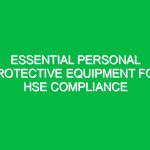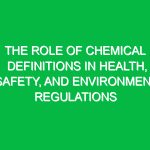What Does PPE Stand For?
Personal Protective Equipment, commonly abbreviated as PPE, refers to specialized gear designed to protect individuals from various hazards encountered in their work environments. In the realm of Health, Safety, and Environment (HSE), PPE plays a crucial role in minimizing risks and safeguarding the well-being of workers across diverse industries. Whether you’re in construction, healthcare, manufacturing, or any other field, understanding what PPE stands for and its significance is essential for maintaining a safe workplace.
PPE encompasses a wide array of equipment, including helmets, gloves, eye protection, high-visibility clothing, and respiratory gear. Each of these items serves a specific purpose, tailored to shield workers from particular dangers. As we delve deeper into the world of PPE, we’ll explore its relevance in HSE, the various hazards it addresses, and the best practices for its effective use.
The Importance of PPE in HSE
The significance of PPE in the HSE domain cannot be overstated. It acts as the final line of defense against workplace injuries and illnesses. In many sectors, hazards are omnipresent. For instance, consider a construction site where heavy machinery operates alongside workers. The risk of falling debris, electrical hazards, and exposure to harmful substances is ever-present. Here, PPE becomes indispensable.
In healthcare settings, the role of PPE is equally critical. During the COVID-19 pandemic, the importance of proper PPE like masks, face shields, and gowns skyrocketed. Health professionals, exposed to infectious agents daily, rely heavily on PPE to protect themselves and their patients. This real-world example underscores the vital nature of PPE in preserving health and safety.
Potential Hazards and Risks Addressed by PPE
Understanding the hazards that necessitate PPE is fundamental for all workers. Let’s explore some of the most common risks across various industries:
1. Chemical Hazards
In many workplaces, employees face exposure to harmful chemicals. These substances can lead to skin irritation, respiratory issues, or even long-term health problems. For instance, in laboratories or manufacturing plants, workers may handle corrosive materials. The right PPE, such as gloves and goggles, can prevent contact with these hazardous substances.
2. Physical Hazards
Construction sites are rife with physical hazards. Workers risk injuries from falling objects, slips, trips, and falls. Hard hats, non-slip footwear, and harnesses are critical pieces of PPE that significantly reduce the likelihood of these injuries. According to the Occupational Safety and Health Administration (OSHA), proper head protection can prevent 85% of head injuries.
3. Biological Hazards
Healthcare workers frequently encounter biological hazards, including viruses and bacteria. PPE such as N95 respirators, gowns, and gloves are essential in preventing the transmission of infectious diseases. For example, during the Ebola outbreak, stringent PPE protocols were implemented to ensure the safety of healthcare workers.
4. Noise Hazards
In industries like manufacturing and construction, excessive noise can lead to hearing loss over time. Earplugs and earmuffs are types of PPE designed to protect workers from harmful noise levels. Personal anecdotes from workers in these environments often highlight the difference that simple ear protection can make in preserving hearing health.
5. Ergonomic Hazards
While not traditionally thought of as a physical hazard, poor ergonomics can lead to musculoskeletal disorders. PPE in this context may include supportive braces or ergonomic tools that promote proper posture and reduce strain during repetitive tasks.
Best Practices and Safety Precautions for PPE Use
The effectiveness of PPE hinges not just on its availability but also on its proper use. Here are essential best practices to ensure maximum protection:
1. Conduct a Risk Assessment
Before selecting PPE, a thorough risk assessment should be performed. Identify potential hazards in the workplace and determine the appropriate type of PPE required for each situation. This proactive step ensures workers are equipped with the correct gear tailored to their specific risks.
2. Training and Education
Providing comprehensive training for all employees on how to use and maintain PPE is vital. Workers should understand the limitations of their gear and how to wear it properly. For instance, a poorly fitted respirator can significantly reduce its effectiveness, exposing workers to respiratory hazards.
3. Regular Inspections and Maintenance
PPE must be regularly inspected for wear and tear. Damaged equipment should be replaced immediately to ensure continuous protection. For example, a hard hat with cracks or a frayed harness can compromise worker safety.
4. Encourage a Safety Culture
Fostering a culture of safety within the organization encourages workers to prioritize PPE use. Management should lead by example, consistently wearing and promoting the use of PPE. Open discussions about safety concerns can also help identify areas for improvement.
5. Compliance with Regulations
Understanding and adhering to regulations governing PPE is crucial. Organizations must stay updated on guidelines set forth by agencies like OSHA or the National Institute for Occupational Safety and Health (NIOSH). Non-compliance can lead to fines and, more importantly, increased risk of injury.
Regulations and Standards Governing PPE
PPE is not just a recommendation; it is often a legal requirement governed by various regulations. Here are some key standards that define the use of PPE in the workplace:
1. OSHA Standards
OSHA outlines specific standards for PPE in various industries. Employers are required to assess hazards and provide appropriate PPE to workers at no cost. This regulation emphasizes the employer’s responsibility in protecting their employees.
2. ANSI Standards
The American National Standards Institute (ANSI) sets standards for PPE, ensuring that equipment meets minimum safety requirements. These standards cover everything from eye protection to fall protection equipment.
3. NIOSH Certification
NIOSH is responsible for testing and certifying respiratory protective devices. Only NIOSH-certified equipment should be used to ensure the highest level of protection against airborne hazards.
4. ISO Standards
The International Organization for Standardization (ISO) provides guidelines for PPE, promoting global consistency in safety standards. Compliance with ISO standards helps organizations improve their safety performance on an international level.
Conclusion
In conclusion, understanding what PPE stands for and its critical role in HSE is essential for every worker and employer. PPE serves as a vital line of defense against a myriad of workplace hazards, from chemical exposure to physical dangers. By recognizing the importance of proper risk assessment, training, and adherence to regulations, organizations can create safer work environments.
As we’ve discussed, the proper use of PPE not only protects individual workers but also contributes to a culture of safety that benefits the entire organization. With the right knowledge and practices surrounding PPE, we can ensure that safety is prioritized, and workers return home unharmed at the end of each day.


